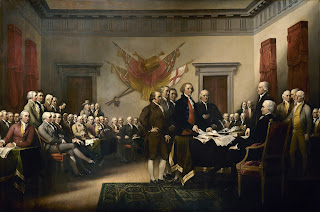 |
| John Quincy Adams about 1783 |
Excerpts from a letter, dated July 27, 1777 from John Adams (1735-1826),
2nd President of the United States and one of the “Committee of 5” –
with Franklin and Jefferson – who drafted the Declaration of Independence. The letter
is to his son, John Quincy Adams (1767-1848), who became the 6th President of the United
States.
“My dear Son, Philadelphia, July 27, 1777
If it should be the Design of
Providence that you should live to grow up, you will naturally feel a Curiosity
to learn the History of the Causes which have produced the late Revolution of
our government. No Study in which you can engage will be more worthy of you…
.I
charge you to consider it with an Attention only to Truth. It will also be an entertaining and
instructive Amusement, to compare our American Revolution with others that
Resemble it…. But above all others, I would recommend to your study, the
History of the Flemish Confederacy, by which the seven united Provinces of the
Netherlands, emancipated themselves from the Domination of Spain….
The most
full and compleat History, that I have seen, is one that I am now engaged in
Reading. It is intituled “The History of the Wars of Flanders…. You will wonder, my dear
son, at my writing to you at your tender Age, such dry Things as these: but if
you keep this Letter you will in some future Period, thank your Father for
writing it.
I am my dear son, with the Utmost Affection to your Sister and
Brothers as well as to you, your Father,
 |
| John Adams (1735-1826) 2nd US President |
[i]
Massachusetts Historical Society Digital Editions.Document No: AFC02d234 (John
Adams to John Quincy Adams) July 27, 1777 at Philadelphia. https://www.masshist.org/publications/apde/portia.php?id=AFC02d234 Accessed July 11, 2013 Abridgement by the author
Copyright 2013 by David Baeckelandt. No reproduction in any format permitted without my express, written consent.






.jpg)






